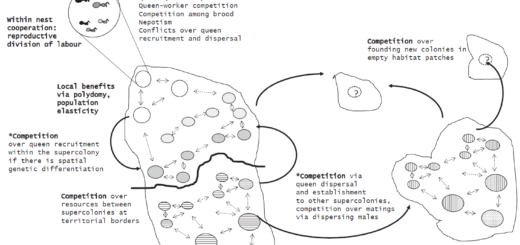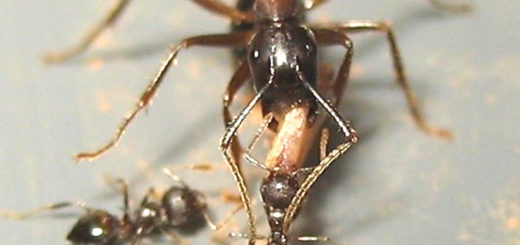A whole lot of zombies: parasitic manipulation in ants
In the recently published review paper “The ants (Hymenoptera: Formicidae) and their parasites: effects of parasitic manipulations and host responses on ant behavioral ecology” in Myrmecological News, Charissa de Bekker, Ian Will, Biplabendu Das, and Rachelle M.M. Adams review ants and their parasites, and how poorly the behavioral and societal change is understood. In this Review, Aniek Ivens highlights their main points.
A Review by Aniek Ivens 
The extended phenotype
A bit more than 35 years ago, Richard Dawkins coined the scientific concept ‘The Extended Phenotype’ in his book with the same name (Dawkins 1982). The extended phenotype consists of those parts of the phenotype encoded by an organism’s genes that are not located in the organism itself. As such, the extended phenotype can consist of any alteration an organism actively makes to its environment (Hughes 2013). The concept became well-known in the context of host-parasite relationships: Some of the best-known examples of the extended phenotype are those of host behavioral manipulation by parasites residing in the host’s body or even outside it (Moore 2002, Hughes & al. 2012, Hughes 2013).
‘Zombie ants’, ant workers that are infected and behaviorally manipulated by their Cordyceps fungal parasite, are such a famous example. In their recent review, De Bekker& al. (2018) discuss this and other examples of parasitic manipulation and host responses in ants. With the genomic revolution well under way, studies of the extended phenotype are now moving from a mostly descriptive natural history focus to a focus on the mechanistic underpinnings of these enigmatic host-parasite interactions. Fittingly, De Bekker & al. not only review the natural history of the ant manipulation phenotypes (and host responses) they discuss but also, if known, the genomic bases of these phenotypes. When, as is the case for many examples, the mechanisms have not yet been unraveled, the review provides detailed suggestions for avenues of future research.
Ant colonies: a parasite’s candy store
Ant colonies can be a candy store to parasites. In their well-organized societies, ants can very effectively collect resources from their environment; needless to say, these resources are also attractive to parasites. Moreover, ants make good hosts for parasites since an ant worker typically comes with her its social network of colony members and thus potential future hosts. A parasite specializing on ants may also be a successful one as ants are found to be ecologically dominant in many ecosystems worldwide. As part of their extended phenotype, these parasites may influence the functioning of individual ants as well as their colonies. Because ants often play key roles in their ecosystems, in-depth knowledge of their parasites and how they affect the ants behaviorally is highly relevant as well. De Bekker & al. (2018) review our current knowledge, and gaps therein, of parasitic manipulation in ants and host responses by ants and discern several patterns observed across systems. Their review is organized by parasite group: viruses, prokaryotes, protozoans, fungi, helminths, and insects. The latter three groups comprise the most and best-studied examples of parasitic manipulation of ants, although the authors suspect that the phenomenon also occurs widely in the other three parasite groups, but these remain understudied thus far. Below examples are highlighted for each of the three best-studied parasite groups, along with some of the grizzly details.
‘Zombie ants’
Ophiocordyceps and Pandora fungi are parasites that target specific ants. Although the two fungi are only very distantly related, infections show quite some similarities. After being infected by fungal spores, the worker ants continue to live for a while, and their nest mates do not recognize them as infected. Eventually, they wander off and display a behavior called ‘summitting’. A summitting ant finds a high point (e.g., the tip of a leaf of grass) to bite into and die. This behavior commonly results from parasitic manipulation and is thought to promote the parasite’s spore dispersal from the dead host. Genomic analyses have shown that these behavioral changes are likely a result of the fungus secreting manipulating proteins rather than, for example, physically invading the ant’s brain (de Bekker & al. 2015).

Camponotus floridanus attached to Spanish moss moments after the final manipulated biting behavior induced by Ophiocordyceps camponoti-floridani. (© Charissa de Bekker)
Yummy berries
Interestingly, summitting has also been observed in ants infected by helminths (parasitic worms). Here, the precise underlying mechanisms remain unknown, but it is known that at least one worm physically inhabits the ant’s brain and likely induces behavioral changes from there. Other worms have been shown to make the infected ants’ gasters, full of the next generation worms, look like tasty red berries. To further aid parasite transmission, the ants are manipulated into flagging their abdomen about, for hungry birds to see. The mechanisms underlying these manipulations are already partly understood.

Breaking the abdomen of a parasitized Odontomachus haematodus trap-jaw ant reveals the mermithid nematode coiled within. These worms infect ant larvae and cause stunted adults. Armenia, Cayo District, Belize. (© Alex Wild)
Off with their heads
Fellow insects may also parasitize on the many resources ant colonies have to offer. Perhaps one of the most enigmatic examples is parasitization by phorid flies. These flies lay their egg in ants, which continue to live while the egg develops. During this time, the ants are manipulated into staying in the secure environment of the ant colony and refrain from foraging activities. The fly eventually turns into a maggot that creeps into the ant’s head, which it continues to eat from the inside. Eventually, just a few hours before the maggot is ready to pupate, the ant climbs out of the colony, the maggot eats its brain, and then the ant’s head falls off, ready to become a shelter for the fly’s pupation. Since these latter phorid flies could potentially be used as biocontrol agents against the Red Imported Fire Ant, a deeper understanding of the mechanistic underpinnings of this sequence is likely underway.

An ant-decapitating fly attempts to separate a fire ant (Solenopsis macdonaghi) from her nestmates. Lone ants make easier targets. Parque Nacional El Palmar, Entre Rios, Argentina. (© Alex Wild)
The review systematically discusses the many examples of parasitic manipulation of ant hosts. However, it also draws attention to the many details that remain unknown and suggests many promising future avenues of research. Future studies that extend their view to ant hosts that are not of direct economic importance may not only uncover more zombies and zombie-makers but also general mechanisms underlying parasite infections.
The larva of a phorid fly trying to make its way out of the head of an infected Camponotus rufipes. (© Charissa de Bekker)
References
de Bekker, C., Will, I., Das, B., & Adams, R.M.M. 2018: The ants (Hymenoptera: Formicidae) and their parasites: effects of parasitic manipulations and host responses on ant behavioral ecology. – Myrmecological News 28: 1-24.
Dawkins, R. 1982: The extended phenotype: the long reach of the gene. – Oxford University Press, Oxford, New York, 307 pp.
de Bekker, C., Ohm, R.A., Loreto, R.G., Sebastian, A., Albert, I., Merrow, M., Brachmann, A. & Hughes, D.P. 2015: Gene expression during zombie ant biting behavior reflects the complexity underlying fungal parasitic behavioral manipulation. – BioMed Central Genomics 16: art. 620.
Hughes, D. 2013: Pathways to understanding the extended phenotype of parasites in their hosts. – Journal of Experimental Biology 216: 142-147.
Hughes, D.P., Brodeur, J. & Thomas, F. (Eds.) 2012: Host manipulation by parasites. – Oxford University Press, Oxford, New York, 240 pp.
Moore, J. 2002: Parasites and the behavior of animals. – Oxford University Press, Oxford New York, 338 pp.
Photograph from Aniek Ivens: © Marten van de Sanden
Featured image: Gratefully received the permission to use it by Alex Wild (https://www.alexanderwild.com/). Check out his blog: http://www.myrmecos.net/





Recent Comments